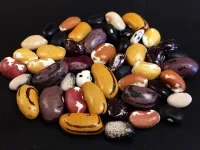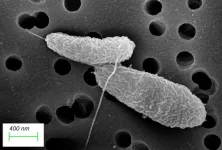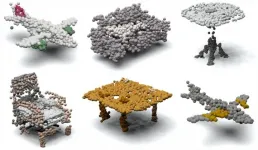(Press-News.org) A 15-year research and advocacy effort to make microwave ovens safer has led to a change in national manufacturing standards that will make microwaves more difficult for young children to open, protecting them from the severe microwave-related burns that scar hundreds of kids under 5 years old in the United States each year. Researchers at Rush University Medical Center and other leaders of the campaign, who worked diligently to document the frequency and severity of these injuries and young children's vulnerability to them, published the results of their efforts in The Journal of Pediatrics on Jan. 20.
"The efforts we have made over the last 15 years have recently led to a change in how microwaves are made. In 2023, manufacturers will be required to incorporate two distinct actions into opening the door of a microwave oven," said Kyran Quinlan MD, MPH, a professor of pediatrics and the director of the Division of General Pediatrics at Rush University Medical Center. Quinlan and fellow Rush pediatrician Gina Lowell, MD, worked closely with colleagues from the University of Chicago Medical Center Burn Unit to achieve the goal of child resistant microwave doors.
"We believed that if young children were less able to open microwave oven doors, they would be less likely to be able to remove the heated items, such as liquids and noodle soups, and they would therefore be less at risk for severe burns," Quinlan added. 'These burns are terribly painful, require burn unit care, and can be life-changing because of the permanent scarring that often results."
An abstract presenting the results from the advocacy effort was chosen as the Program Description Abstract of the Year during the annual conference of the Injury Free Coalition for Kids in December 2019.
According to the American Burn Association, 22.5% of the patients in burn units across the United States are children, and most of the children are admitted for scalds rather than burns suffered in fires.
The researchers' 15-year journey began with documenting the issue, and learning how microwave ovens are regulated and how to effectively advocate for child-resistant microwave oven doors. In 2008, the researchers published an analysis of three years of burn unit data that found that a significant percentage of burns involved young children opening a microwave themselves and removing and spilling the oven's heated contents.
In that report, the youngest child burned was 18 months old, and nearly half of the cases required skin grafts -- a process of removing skin from one part of the body to cover the section of skin that was burned.
The researchers then evaluated and documented the abilities of healthy young children ages 15 months to 4 years to use microwave ovens. They recorded whether the children could open the microwave oven door with either a push mechanism or a pull mechanism, turn on the microwave and remove its contents.
The study revealed that children as young as 17 months could open both a push- and a pull-open microwave oven door, remove what was in the microwave, and even turn it on. Nearly all children were able to perform each of these tasks by the age of 2.
The researchers then worked to submit a proposed change in the design requirements of microwave oven doors to make them more difficult for young children to open. Quinlan and Lowell worked with the child product safety advocacy group Kids in Danger to enlist college engineering students to design child-resistant microwave doors to demonstrate their feasibility. The team also presented their research at national meetings and created a short video to put a face with the statistics about microwave-related childhood burns.
Eventually, Quinlan and Marla Robinson MSc, OTR/L, assistant director of therapy services at University of Chicago Medical Center and a partner in the advocacy campaign, became voting members of the Underwriters Laboratories Standards Technical Panel for microwave ovens, which sets the standards required for any microwave sold in the United States.
After previous failed attempts to change the standard for microwave oven doors, the panel passed the change by a single vote in September 2018. The new microwave ovens also will be required to include labels warning families of the risk of severe scalds to young children.
"Early on, we felt that making microwave oven doors harder to open would truly protect young children from these burns, which were frequently severe," Quinlan said. "This took longer than we expected, but it was so worth it.
"We knew we had work to do to share this idea and to provide enough information to convince others who could be a part of the change we sought, but ultimately, our idea was a good one, and with persistence we realized our goal."
INFORMATION:
January 20, 2021 - Plant breeders are constantly working to develop new bean varieties to meet the needs and desires of the food industry. But not everyone wants the same thing.
Many consumers desire heirloom-type beans, which have great culinary quality and are visually appealing. On the other hand, farmers desire beans with better END ...
Scientists have discovered how bacteria commonly responsible for seafood-related stomach upsets can go dormant and then "wake up".
Vibrio parahaemolyticus is a marine bacterium that can cause gastroenteritis in humans when eaten in raw or undercooked shellfish such as oysters and mussels.
Some of these bacteria are able to turn dormant in poor growth conditions such as cold temperatures - and can remain in that state of hibernation for long periods before resuscitating.
University of Exeter scientists have identified a population of these dormant cells that are better at waking up, and have discovered an enzyme involved in that waking up process.
"Most of these bacteria die when they encounter poor growth conditions, but we identified sub-populations ...
BEER-SHEVA, Israel...January 20, 2021 -Ben-Gurion University of the Negev researchers have discovered that the protein BMP5/7 offers promising therapeutics that could slow down or halt the progression of Parkinson's disease.
The findings were published in the prestigious clinical neurology journal, END ...
A new negative pressure ventilator which could provide additional treatment options for patients with respiratory failure, including those with COVID-19 - and whose design can be easily adapted to developing countries - has been created by a team that includes anaesthetists, nurses and engineers. Details on the new exovent system - which is similar in design but much smaller in scale and easier to use than the devices used to help treat polio patients during the 1950s - are published in Anaesthesia (a journal of the Association of Anaesthetists).
Use of this system ...
Protected areas are critical to mitigating extinction of species; however, they may also be in
conflict with efforts to feed the growing human population. A new study shows that 6% of all
global terrestrial protected areas are already made up of cropland, a heavily modified habitat
that is often not suitable for supporting wildlife. Worse, 22% of this cropland occurs in areas
supposedly enjoying the strictest levels of protection, the keystone of global biodiversity
protection efforts.
This finding was published in the Proceedings of the National Academy of Sciences by
researchers at the University of Maryland's National Socio-Environmental ...
The Tiger Rattlesnake possesses the simplest, yet most toxic venom of any rattlesnake species, and now new research from a team lead by a University of South Florida biologist can explain the genetics behind the predator's fearsome bite.
Published in the new edition of "Proceedings of the National Academy of Sciences," USF Department of Integrative Biology Assistant Professor Mark Margres and colleagues across the southeastern United States have sequenced the genome of the Tiger Rattlesnake to understand the genotype of the venom trait. Despite the simplicity of the Tiger Rattlesnake's venom, Margres says it is roughly 40 times more toxic than the venom of the Eastern Diamondback ...
A new therapy developed by researchers at Rush University Medical Center is showing success as a way to prevent COVID-19 symptoms in mice.
In a study published in the Journal of Neuroimmune Pharmacology, mouse models with COVID-19 showed positive results when a small peptide was introduced nasally. The peptide proved effective in reducing fever, protecting the lungs, improving heart function and reversing cytokine storm -- a condition in which an infection triggers the immune system to flood the bloodstream with inflammatory proteins. The researchers also report success in preventing the disease from progression.
"This ...
Disasters in high-risk industries can have catastrophic environmental, financial and human safety consequences. One way these industries help prevent and mitigate disasters is formal procedures designed to standardize how work is done. These procedures typically come in the form of a written document workers use while performing a task.
Camille Peres, associate professor at the Texas A&M University School of Public Health, said that there are two models of safety companies usually follow to varying degrees, whether they realize it or not. Safety model one "is very much a control paradigm," Peres said. "The idea the company has is that if they control absolutely everything that's going on, then they will be safe." This ...
Before he joined the University of Texas at Arlington as an Assistant Professor in the Department of Computer Science and Engineering and founded the Robotic Vision Laboratory there, William Beksi interned at iRobot, the world's largest producer of consumer robots (mainly through its Roomba robotic vacuum).
To navigate built environments, robots must be able to sense and make decisions about how to interact with their locale. Researchers at the company were interested in using machine and deep learning to train their robots to learn about objects, but doing so requires a large dataset of images. While there are millions of photos and videos of rooms, none were shot from the vantage point of a robotic vacuum. Efforts to train using images with human-centric perspectives failed.
Beksi's ...
Following a series of studies on termite mound physiology and morphogenesis over the past decade, researchers at the Harvard John A. Paulson School of Engineering and Applied Sciences have now developed a mathematical model to help explain how termites construct their intricate mounds.
The research is published in the Proceedings of the National Academy of Sciences.
"Termite mounds are amongst the greatest examples of animal architecture on our planet," said L. Mahadevan, the Lola England de Valpine Professor of Applied Mathematics, of Organismic and Evolutionary Biology, and ...




